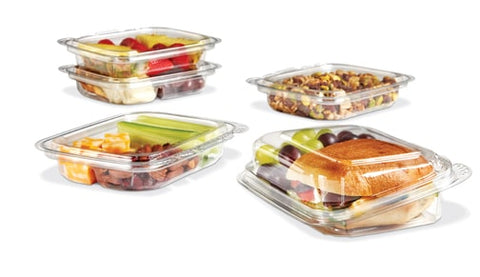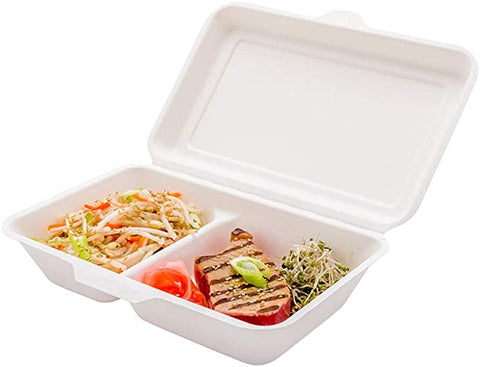
Types Of Eco-Friendly Food Packaging
Switching from single-use Styrofoam containers and plastic bags to more eco-friendly disposables is an easy way for your business to reduce its environmental impact while appealing to your customers. Whether you're looking for eco-friendly materials to align with your sustainable menu or to comply with new regulations, there is an eco-friendly food packaging solution for you!
Types of Eco-Friendly Alternatives to Styrofoam Take-Out Containers
From reusable options to recycled plastic and paper materials or completely plant-based
PET (polyethylene terephthalate) plastic is a strong, lightweight, and clear plastic that does not react with food products, making it a popular and cost-effective option for packaging foods and beverages. Plus, because of its ability to be recycled multiple times to create new products, PET plastic is an energy-efficient plastic and many food containers are often made with recycled content.
- Durable, shatterproof construction
- Most are freezer safe, making them great for transporting cold foods
- 100% recyclable; most easily and commonly recycled plastic
- BPA-free
- Derived from recycled petroleum-based plastics

PLA Plastic Containers
- Suitable for both hot and cold applications
- Has a smaller carbon footprint than traditional plastics
- BPA-free
- Only compostable under industrial composting conditions
- Not all PLA plastics are created equal – some crops used to create the plastics could have been grown with non-eco-friendly fertilizers and pesticides
- Because they are chemically different, they must be properly recycled separate from traditional plastics; recyclable #7

Sugarcane / Bagasse Containers
Sugarcane / bagasse is a plant-based, tree-free, renewable material made from the waste of sugarcane plants leftover after the sugar has been extracted. This fibrous, pulpy material is used to create durable containers that appeal to environmentally conscious consumers and requires much less energy to produce than plastic products.- Suitable for both hot and cold applications
- Sturdy enough to handle greasy foods
- 100% biodegradable and compostable
- Microwave and refrigerator safe
- Unbleached design does not contain toxic dyes
- Must be composted in a commercial composting facility
- More costly than other foam alternatives

- Leak- and grease-resistant, making them strong enough to hold up to sauces, gravies, and oils
- Breathable to let steam and moisture out to prevent foods from getting soggy
- Natural kraft color does not contain toxic dyes
- Recyclable and typically contains recycled content
- Poly coating makes the material harder to recycle
- May not be sourced from sustainably managed forests
- Durable, cut-resistant construction
- Non-absorbent and leak-resistant, making them great for holding saucy foods
- Suitable for both hot and cold applications
- Microwaveable
- Recyclable at the end of their service life
- Still made with non-renewable plastic material

Reusable Polypropylene Containers
- 100% BPA-free
- Microwave-safe and dishwasher-safe
- Durable, break-resistant and leak-resistant design
- Each container can be used for up to 1000 uses
- Recyclable at the end of their service life
- Higher initial cost than other eco-friendly options
- Not a cost-effective option for businesses in more tourist-central locations or locations that mainly serve guests that aren’t likely to return frequently

Molded Pulp Fiber Containers
- Made from recycled content and renewable resources
- Typically biodegradable and/or compostable
- Typically do not contain chemical additives, coatings, or dyes
- Not all molded pulp is created equal due to the properties of the different fibers used
Types of Eco-Friendly Alternatives to Plastic Bags
If you are choosing to make the switch to more eco-friendly containers for your take-out service, it is also wise to consider switching other items involved in your delivery system to keep your brand consistent to consumers. Several eco-friendly products are available to help you replace single-use plastic bags in your establishment for good.- 100% biodegradable and recyclable. There are also certified compostable options available
- Typically can withstand more pressure or weight than plastic bags
- Often times can be reused
- Typically more expensive than plastic bags
- May not be sourced from sustainably managed forests

Reusable Plastic Bags
Reusable plastic bags are a great option for businesses looking to transition to more earth-friendly options without compromising on the durability or flexibility of traditional plastic bags. Plus, reusable plastic bags are easy to clean with a sanitary wipe.- Made with recyclable, durable HDPE or LDPE plastics
- Often accepted in local curbside recycling programs
- Biodegradable options
- Cost-effective solution to single-use plastic bags
- Still made with non-renewable plastic material

Take-Out Boxes
- Grease-resistant paperboard construction
- Breathable to let steam and moisture out to prevent foods from getting soggy
- Recyclable and compostable options
- May not be sourced from sustainably managed forests
Why Switch to Styrofoam Alternatives?

Styrofoam is a trademarked material that is commonly used to classify all types of expanded polystyrene (EPS) foam products. Polystyrene products are recyclable and are marked with the recyclable number "6". However, these products are very rarely actually recycled. Few local governments accept Styrofoam products in curbside recycling bins, and there are few recycling centers that accept and recycle Styrofoam because it can be a difficult and costly process. As a result, Styrofoam has become a major environmental problem for a few reasons:
- Styrofoam is not biodegradable, meaning it does not naturally degrade over time, and it takes up an estimated 1/3 of the world's landfill space.
- Oftentimes, polystyrene foam products will break down into smaller pieces that pollute the land and waters, which pose threats to wildlife and make cleanup efforts difficult.
- Studies suggest that styrene, polystyrene foam's main ingredient, is likely a human carcinogen that can cause health problems with long-time exposure.


